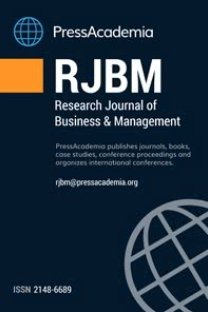COMPARATIVE ANALYSIS OF EU COUNTRIES AND TURKEY IN TERMS OF INNOVATION PERFORMANCE
___
- Aras G., Tezcan N., Furtuna Ö. K., Aybars A. (2014), Firmaların Ar-Ge Ve İnovasyon Performansının Stratejik
- Analizi, İTO Yayın No:2014-10
- Bremmer, J., Oude Lansink, A. G. J. M. and Huirne, R.B.M. (2008), “The impact of innovation, firm growth and perceptions on technical and scale efficiency’, Agricultural Economics Review, Vol.9, No.2, p.65-85
- Crescenzi, R., Rodríguez-Pose, A. and Storper, M. (2007) The Territorial Dynamics of Innovation: A Europe-United
- States Comparative analysis, Journal of Economic, Geography, 7 (6). p. 673-709. ISSN 1468-2702
- Bülbül, S., Köse, A. (2010), “Türkiye’de Bölgelerarası İç Göç Hareketlerinin Çok Boyutlu Ölçekleme Yöntemi ile İncelenmesi”, İstanbul Üniversitesi İşletme Fakültesi Dergisi, Cilt:39, Sayı:1, İstanbul, p.75-94
- Coad, A. and Rao, R. (2006), “Innovation and Market Value: A quantile regression analysis”, Economics Bulletin, Vol.5, No.3, p.1-10
- Diaz-Balteiro, L., Herruzo, A. C., Martinez, M. and Gonzales-Pachon, J. (2006), “An analysis of productive efficiency and innovation activity using DEA: An application to Spain’s wood-based industry”, Forest Policy and Economics, Vol. 8, p. 762-773.
- EU, (2014), Innovation Union Scoreboard 2013
- EU, (2013), Innovation Union Scoreboard 2012
- Feeny, S., Rogers, M. (2001), “Innovation and performance: Benchmarking Australian firms”, Melbourne
- Institude Working Paper, No. 7/01, ISSN 1328-4991.
- Garson, G.D. (2014), Cluster Analysis, Statistical Associates Blue Book Series.
- Griliches, Z. (1980), “Returns to research and development expenditures in the private sector” In. Kendrick, J.
- Vaccara, B. (Eds.), New developments in productivity measurement and analysis, conference on research in income and wealth, Vol. 44, Chicago University Press for the National Bureau of Economic Research, Chicago, p. 419-461
- Griliches, Z. Mairesse, J. (1984), “Productivity and R&D at the firm level”, In: Griliches, Z. (Ed.), R&D, Patents and Productivity. Chicago University Press for the National Bureau of Economic Research, Chicago, p. 339-374
- Guan, J. C., Yam, R. C. M., Mok C. K. and Ma, N. (2006), “A Study of the relationship between competitiveness and technological innovation capability based on DEA models”, European Journal of Operational Research, Vol. 170, p. 971-986.
- Hair J.F., Black W.C., Babin B.J., Anderson R.E., Tatham R.L. (2006), Multivariate Data Analysis, Sixth Edition
- Hall, B. H. (1999), “Innovation and Market Value”, Working Paper Series 6984, National Bureau of Economic Research
- Kalaycı Ş, Albayrak A.Ş., Eroğlu A., Küçüksille E., Ak B., Karaatlı M., Keskin H. Ü., Çiçek E.U., Kayış A., Antalyalı Ö.L., Uçar N., Demirgil H., İşler D.B., Sungur O. (2008), SPSS Uygulamalı Çok Değişkenli İstatistik Teknikleri, Asil Yayın Dağıtım, İstanbul
- OECD (2005), Oslo Manuel, Guidelines For Collecting And Interpreting Innovation Data, Third Edition, Çeviri: TÜBİTAK, http://www.tubitak.gov.tr/tubitak_content_files/BTYPD/kilavuzlar/Oslo_3_TR.pdf “Yenilik Verilerinin Toplanması ve Yorumlanması İçin İlkeler”
- Orhunbilge N. (2010), Çok Değişkenli İstatistik Yöntemler, İstanbul, İstanbul Üniversitesi Yayın No: 4942
- Tatlidil H. (1996), Uygulamalı Çok Değişkenli İstatistiksel Analiz, Ankara
- T.C. AB Bakanlığı (2015), Türkiye-AB İlişkileri http://www.ab.gov.tr/index.php?p=
- T.C. Kalkınma Bakanlığı (2013), Onuncu Kalkınma Planı (2014-2018) http://www.kalkinma.gov.tr/Lists/Kalknma%20Planlar/Attachments/12/Onuncu_Kalkınma_Planı.pdf
- TPE (2015), İstatistikler http://www.tpe.gov.tr/TurkPatentEnstitusu/statistics/
- TÜİK (2015), “Ar-Ge Faaliyetleri İstatistikleri”
- WIPO (2015), Statistical Country Profiles, http://www.wipo.int/ipstats/en/statistics/country_profile/profile.jsp?code=AT
- WIPO & INSEAD (2014), The Global Innovation Index 2014
- World Bank (2014), World Development Indicators http://databank.worldbank.org/data/views/variableSelection/selectvariables.aspx?source=world-development- indicators#s_c EKLER
- Yayın Aralığı: Yılda 4 Sayı
- Başlangıç: 2014
- Yayıncı: PressAcademia
Orhan GOKOVA, Ayse Gozde YASAR, Ahmet ASLAN, Gurel CETİN
Ghassan OMET, Talal AL-SHARARİ, Bashar Abu KHALAF, Hadeel YASEEN
